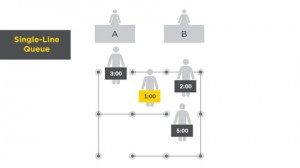Population density continues to increase in many metropolitan areas. In turn, the demand for goods also rises. Many big-box stores are recognizing this trend and positioning themselves where the shoppers are. A recent trend report for 2015 states that several of the major retailers have plans to open smaller-format stores in more urban areas. Downsized stores and an influx of new shoppers means that queue management will be more important than ever for these retailers as they seek to maximize throughput, in small spaces, while maintaining a positive customer experience. Let's take a look at what queuing strategies these "small box" stores might turn to and what other small-store retailers can also learn:
1. The single-line, multi-server queue configuration

Although it’s easy to think otherwise, the single-line, multi-server (or single-server) queue configuration works well in smaller-format stores. One serpentine line is not only a space saver, it is proven to result in faster service and a more efficient line overall. (Learn more about the single-line queue here.)
2. Merchandising in the queue
Merchandising in the queue serves a number of objectives, including increasing impulse sales and profit per square foot, keeping customers engaged while they wait, and reducing perceived wait times. In a small store environment, taking advantage of what might otherwise be wasted space (from a sales standpoint), is a valuable idea.

3. Maximizing floor space in and around the queue
Once again, when every square foot matters and you have less to work with, it’s important to maximize what you’ve got. In and around the queue, this means using a merchandising system that requires a small footprint and allows for merchandising on the inside and/or outside of the queue.
4. Space to wait
In a smaller space, it may be tempting to reduce the queue footprint, but keep in mind that your queue must still be wide enough to accommodate carts, strollers, wheelchairs, oversized items, and the like. If your customers are comfortable, they’re more likely to stay put.

5. Queue analytics
Mistakes in a smaller store format can have a far more noticeable impact. When a checkout line gets backed up or too long, there’s no room to hide that overflow. Small stores can benefit from technology that counts customers and reports wait time in real time. Information from queue analytics can help managers maintain adequate staffing, open checkout points, and acceptable wait times, preventing problems before they escalate. As you can see, smaller stores have unique needs. These strategies can help you serve more customers, faster, and with greater satisfaction and profits. Which of these ideas will you adopt?













